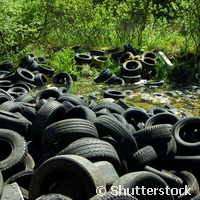Recycling Europe's three million tonnes of tyre waste
Almost 1 billion tyres reach their end of life around the world - some 350 million of this number in the EU. This quantity is increasing every year. Waste tyres are potentially fully recyclable. The recovered materials can be put to other uses, in turn reducing the environmental impact of this priority waste stream. With this aim, the EU-funded project TyGRE ('High added value materials from waste tyre gasification residues') sets out to find new uses for Europe's waste tyres - estimated to be 3.5 million tonnes a year. Tyres contain steel, and a large amount of organic materials, which can be used instead of coal or biomass as a fuel source or as secondary raw materials for high added-value by-products. The project team is investigating new ways to harness this resource through a process able to produce a fuel gas or 'syngas' (mainly a mixture of hydrogen, carbon monoxide and dioxide, and methane), along with a ceramic material, silicon carbide. Leading this project is the Italian national agency for new technologies, energy and sustainable economic development, ENEA, in Portici, near Naples. Sabrina Portofino, a researcher at ENEA, says such by-products are a 'must' in the recycling process. 'Basically, the main idea consists in redirecting the gasification process towards the material recycling,' she says. 'Therefore, to increase the added value of the gasification we decided to couple a second process, dedicated to the synthesis of ceramics, such as silicon carbide - the carbon reacts with silicon oxide at high temperature to form silicon carbide.' Silicon carbide can be used in the manufacture of ceramic materials and for electronic applications. The project received EUR 3.3 million in EU-funding. The research consortium involves researchers and companies representing the main value chain involved - tyre recycler, ceramic powders final user and pyro-carbons producer. Significant achievements have been made since the start of the project in 2009. The new process has been developed and tested at laboratory scale. A prototype plant was installed at ENEA's facilities in Trisaia. The consortium aims to process 20 kilograms per hour of tyre waste. Operating the prototype will establish the sustainability of TyGRe recycling scheme. The project team will then be able to assess the energy balance of the whole process.For more information, please visit: TyGRE http://www.tygre.eu(opens in new window) Project factsheet Italian National Agency for New Technologies, Energy and Sustainable Economic Development http://www.enea.it/en/home?set_language=en&cl=en(opens in new window)
Countries
Italy



